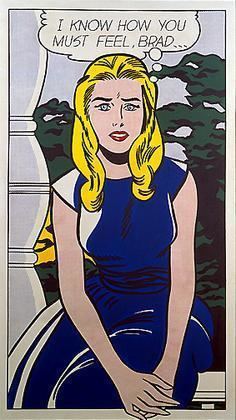Year 1964 Artist Roy Lichtenstein | Movement Pop art Created 1964 | |
 | ||
Dimensions 174 cm × 95.9 cm (68.5 in × 37.75 in) Location Wallraf-Richartz Museum, Cologne Similar Roy Lichtenstein artwork, Other artwork | ||
I Know...Brad (sometimes I Know How You Must Feel, Brad) is a 1964 pop art painting by Roy Lichtenstein that uses his classic Ben-Day dots and a speech balloon. The work is located at the Wallraf-Richartz Museum in Cologne. It is an example of how Lichtenstein used his artistry to make significant changes to the original comics sources.
Contents
Background
Lichtenstein stated that the name Brad sounded heroic to him and was used with the aim of cliched oversimplification.
Background
Measuring 174 cm × 95.9 cm (68.5 in × 37.75 in), I Know...Brad is considered an ironic depiction of emotional expression. The work is a three-quarter-length, single image of a lovelorn girl. This is one of Lichtenstein's post-1963 comics-based women that "...look hard, crisp, brittle, and uniformly modish in appearance, as if they all came out of the same pot of makeup."
Details
According to a reproduction of Ellen H. Johnson's article entitled "Lichtenstein and the Printed Image" from Art and Artists (London, June 1966) the painting is somewhat removed from the original, while satirically mimicking several elements of it:
The slick black contours in I Know How You Must Feel, Brad wittily parody the crazy 'grace' of the pointed fingers, narrow wrist, swelling hips and breast and the flowing blonde hair of the comic. But for all the mannerism in Lichtenstein's American beauty (who numbers Ingres' Madame Moitessier among her ancestors), the total work is a powerful, commanding painting at least as far removed from the original comic as Seurat's paintings are from Chéret's posters.
Johnson notes how Lichtenstein transforms the comic inspiration not only by enlarging the scale, but he also by eliminating non-essential details such as fingernails and traces of forearm musculature. In addition, by varying and reducing the number of lines he presents a better depiction of their character. His color change makes the work more dynamic and the subject more idealized. He also makes the landscape background more robust. Lichtenstein stated that the name Brad sounded heroic to him and was used with the aim of cliched oversimplification. The work presents an "...unmistakeable acknowledgement to the flamboyant linearism of Art Nouveau...".
